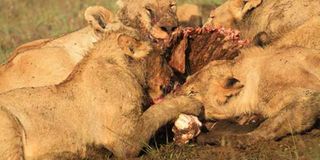Premium
Lions in Kenya could be extinct in two decades, experts warn

Lions feast on a wildebeest at the Maasai Mara Game Reserve. Experts have warned that lions in Kenya are being driven to extinction by humans who are encroaching on their territory. PHOTO | GEORGE SAYAGIE | NATION MEDIA GROUP
What you need to know:
- Lion’s future is now threatened by the destruction of its habitat as man spreads into the king’s frontiers in search of space to live and farm.
- Land conversion in the Maasai Mara is suffocating the ecosystem that is vital to the survival of many species, including lions.
For anyone visiting the Maasai Mara Game Reserve, the thrill is to see the ultimate king of the jungle.
However, the lion’s future is now threatened by the destruction of its habitat as man spreads into the king’s frontiers in search of space to live and farm.
Conservationists and wildlife groups have warned that lions in Kenya could be gone in two decades.
Land conversion in the Maasai Mara is suffocating the ecosystem that is vital to the survival of many species, including lions.
So serious is the situation that plans are afoot to have the lion placed on Appendix One of the Convention on International Trade in Endangered Species of Wild Fauna and Flora (Cites).
SAVANNAH DIMINISHED
Narok Wildlife and Environment Forum chairman Nick Murero recently said the savannah had diminished by 75 per cent, following massive human encroachment.
“Grasslands have shrunk to a quarter of the size they used to be. With that, the areas that lions call home have been replaced by farms and grazing fields,” he said.
He added that as lions are pushed out of their shrinking space, they come into contact with livestock, resulting in their killing by pastoralists.
Mr Antony ole Tira, a lion research expert at Matira camp, agrees with Mr Murero.
ROAM TERRITORIES
He said a lion’s roar can be heard 10 kilometres away and the big cats naturally roam territories as vast as 260 square kilometres.
“There is a very big problem. Members of the surrounding community have leased their lands to conservancies are now encroaching on protected area in the game reserve, interfering with lion territories,” said Mr Tira.
“Lions are now killing one another in territorial disputes while others are being pushed to the Serengeti in Tanzania or privately-owned lands, for survival.”
Last week, Governor Samuel Tunai’s administration announced a ban on livestock grazing in the world-famous reserve and imposed a Sh10,000 fine for every cow impounded.
ADULT LIONS
“Twenty years ago, one could encounter more than 250 resident adult lions when visiting the reserve but you will be lucky to come across 120 today.
Unfortunately, the number is still falling,” Mr Murero said.
His forum has been assessing the distribution and status of wild animals in the reserve.
“The king is walking into oblivion and very few people seem to be getting the message. People see lions in tourist hotspots and think they are everywhere,” he said.
VAST AREAS
“The truth is the animals need vast areas to roam. Only a few parks and game reserves can satisfy their need for space, prey and protection. Outside protected areas, conflict with pastoralists is inevitable.”
According to a 2009-2014 report by the Kenya Wildlife Service on conservation and management strategy for lions in Kenya, the big cat’s population on the continent has gone down by 30 to 50 per cent.
It is estimated that the population stood at between 23,000 and 39,000, a terrifying dive towards extinction.
In 2015, four lions from the Marsh Pride which featured in the world-famous documentary Big Cat Diary, were killed by herdsmen whose cattle were grazing illegally in the park.
FOUR ANIMALS
“Post-mortem examination on the four animals and more than a dozen vultures that fed on the carcases indicated that they were poisoned,” he said.
The spear
In recent years, the lions’ rapid population fall has been hastened by the use of the pesticide Furadan.
Production of the pesticide has stopped but it is still widely available in Kenya.
Pastoralists lace meat or carcases with the poison to kill the lions. Herders have learnt that the poison is more lethal and effective than the spear.
The KWS report estimated that the population of lions in Kenya in 2002 was 2,749 but dropped to 2,280 in 2004.





